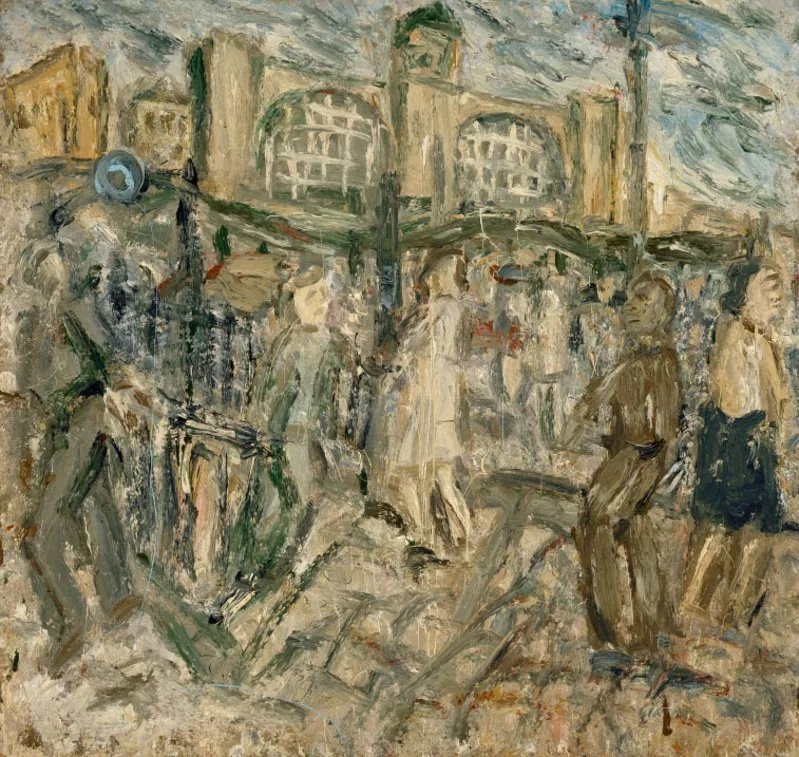Charles Saumarez Smith's Pocket Treasure
7 October 2021
Writer, curator and art historian, Charles Saumarez Smith tells us about a work of art with particular meaning to him - the next instalment of our series looking at different people’s ‘pocket treasures’.
Joe Lloyd
Joe Lloyd is a journalist who writes about architecture and visual art for The Culture Trip, Elephant, and The Economist's 1843 magazine, among others.
A reclining figure by Philip Eglin (1959 - ), image courtesy of Charles Saumarez Smith.
Until recently, visitors to Charles Saumarez Smith’s London residence would be greeted by a recumbent form: a nude by the Wales-based ceramic artist Philip Eglin, reclining on a low, slim base. Flesh-coloured, with lines and dapples of green, she places her right arm around her left side in a gesture of confidence and relaxation.
“I bought it as a Christmas present for my wife,” recalls Saumarez Smith, “from the Crafts Council shop at the V&A, in probably 1985 or 1986.” It was at an early stage in Eglin’s career, around the time of his graduation from the Royal College of Art. “The reason it struck me,” continues Saumarez Smith, “is that it was, in a way, the first serious work of art I bought.”
As a writer, curator and art historian, as well as the former Chief Executive of the Royal Academy and Director of the National Gallery, Saumarez Smith has spent his life to date surrounded by canvases. But his own home — an 18th century townhouse in Stepney which he and his wife, artist and jeweller Romilly Saumarez Smith, restored from a state of dilapidation — abounds with a different art form. “I've never really been able to buy paintings,” he explains, “they've always been too expensive. So I've often sort of bought, not in a very conscientious way but in a casual way, ceramics. And I’ve always liked the way ceramics has maintained a figurative work, at a time when it has been in some ways relegated from fine art practice. Phil Eglin is a good example of that.”
Eglin has an enormously distinctive practice. His oeuvre includes jugs, drug jars, cups, plates, dishes and buckets, as well as figurative forms. He draws upon both high culture — gothic carvings, Chinese porcelain, Manet’s Le Déjeuner sur l’herbe, Cy Twombly’s Bacchus abstracts— and the ephemera of modern life, including packaging labels and footballers, to create surprising, astounding collisions across time and taste. He is often irreverent : a piece entitled Popes and Prostitutes (2010) alternates caricatures of its two eponymous sets on a robed ecclesial figure, while Christ Beckham (2009) places an image of David Beckham, arms stretched, on the chest of the crucified saviour.
“I’ve always felt,” says Saumarez Smith, "he's been very interesting in the way he's absorbed visual references from medieval art and from popular culture in a very effective way.” In juggling these concerns within a craft-based medium, Eglin occupies a curious place in contemporary practice. “I don’t know,” says Saumarez Smith, “the extent to which he views himself as a fine artist or a ceramic artist, or somewhere in between the two.” He compares Eglin to Grayson Perry, also a “very independently-minded figurative potter” who “absorbs visual references in a similarly eclectic way”. But whereas Perry has been raised to the art world, Eglin has plotted his own trajectory in the realm of ceramics.
The reclining nude began an affinity with Eglin’s work. “We have collected other work by Eglin,” explains, “not in a very systematic way. And not recently because my house is full of stuff. I certainly have never regarded myself as the sort of collector who goes on collecting beyond what one's able to display and live with.” Another favourite ceramist is the South African Hylton Nel, whose works include vases and plates with satirical texts and a menagerie of humorous cats. “I've always liked the fact that with ceramics,” says Saumarez Smith, “that sense of being able to live with things and to handle them and use them. And not treat them simply as objects of value.”
Saumarez Smith moved to his present address in 2000, and for much of that time the figure lived atop a big wooden chest next to the front door. “I've always been petrified,” he explains, “because everyone puts the post next to it. I bought it for not a huge amount of money, but as time has gone by it’s not just that it has become financially valuable -- it’s probably not that financially valuable — but it's certainly got sentimental value. I'm always terrified that someone's going to put a parcel and chop off a little bit.” After two decades of worry, it has now found a new home: “I recently moved it to our dining room because I just can't bear it anymore.” Safe at last.





